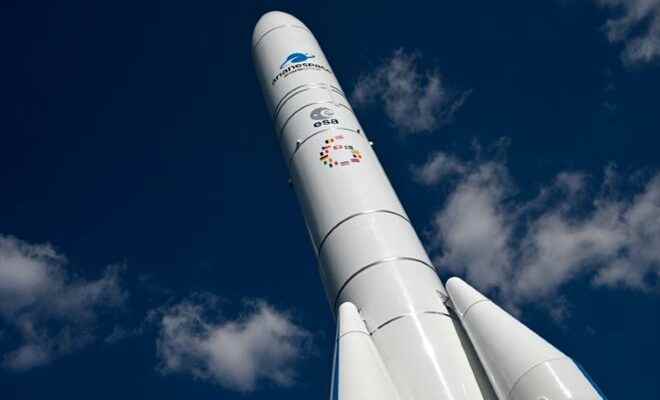The launch site of the Vega-C rocket for its maiden flight on July 12, 2022 in Kourou, Guyana (AFP/Archives/jody amiet)
Europe suffered overnight from Tuesday to Wednesday the failure of the first commercial flight of the new Vega-C rocket from Kourou, depriving the continent in the short term of an autonomous solution to launch its satellites, after the delay of Ariane 6 and the impossibility of using the Russian Soyuz rocket.
The small Vega-C rocket is grounded, while an “independent” commission of inquiry establishes “the cause of the failure and proposes solid and lasting corrective actions to guarantee a safe and reliable return to flight” of the launcher , announced, the gloomy mine, the president of Arianespace, Stéphane Israel, during a brief press conference in Kourou.
Beyond the last two launches of Ariane 5 and two others of Vega, Europe no longer has its own means of launching its satellites before the first flight of Ariane 6 scheduled for the fourth quarter of 2023, or the resumption of Vega-C flights.
Two minutes and 24 seconds after takeoff on Tuesday at 10:47 p.m. local time (01:47 GMT), the trajectory of the small rocket deviated from that programmed, then the telemetry stopped arriving at the control room of the Space Center in Kourou, Guyana French.
Launched above the Atlantic Ocean, Vega-C had just exceeded 100 kilometers in altitude and was then just over 750 kilometers north of Kourou.
The order to destroy the launcher was then given by CNES, the French space agency, as the launch authority in Kourou. The debris fell back into the sea. “No damage to persons or property has been observed”, according to Arianespace, responsible for the operation of European launchers.
According to Pierre-Yves Tissier, technical director of Arianespace, “the failure seems to be limited to the Zefiro 40”, the second stage of the launcher built by the Italian Avio. The flight data was recovered for analysis purposes.
“We take full responsibility for this failure of Vega-C,” said Avio boss Giulio Ranzo.
– Complex exercise –
If the multiplication of the number of space launches in recent years, under the impetus in particular of the American SpaceX, tends to trivialize the exercise, the European failure is a reminder of its complexity.
“So sorry to hear this. This is a harsh reminder of how difficult orbital spaceflight is,” SpaceX CEO Elon Musk tweeted. “It’s much more complicated than most people think,” said Peter Beck, boss of the Rocket Lab mini-launcher.

The European light launcher Vega-C (AFP/Aude GENET)
Vega-C, which was the first commercial flight after a successful qualification launch in July, was to place two Airbus Earth observation satellites, Pléiades Neo 5 and 6, into orbit, making it possible to image any which point of the globe several times a day with a resolution of 30 cm.
It is also a disappointment for the European giant, which developed this program on its own funds, whose services are sold to both companies and the military.
Satellites providing commercial revenue are generally insured. According to a connoisseur of the sector, Pléiades Neo 5 and 6 were covered up to 220 million euros by a consortium of insurers, allowing, if Airbus decides, to manufacture them again. Asked by AFP, Airbus did not comment.
– Nine launches, three failures –

Takeoff of the Vega-C rocket for its maiden flight on July 13, 2022 in Kourou, French Guiana (ESA-CNES-Arianespace/Optique/AFP/Archives/S MARTIN)
The loss of these satellites is also bad news for the armies, particularly the French ones, customers of the high-resolution images provided by this Airbus constellation to monitor the situation in Ukraine in particular, while the French military observation satellite CSO-3 n still could not be launched due to lack of availability of the Soyuz and Ariane 6.
Initially scheduled for November 24, this flight had been postponed for a month due to a defective element “related to the fairing”, Mr. Israel told AFP. Unrelated a priori therefore with the failure of this night.
Presented as the little sister of Ariane 6, the Vega rocket uses certain common elements (the P120C main stage).
Vega-C is an improved version of the Vega light launcher, which is the third failure of the last nine launches, when Ariane 5 has had two in 115 launches since 1996. And Space X’s Falcon 9 none in 59 launches since the beginning of the year.

The Ariane 6 launcher exhibited at the 73rd International Astronautical Congress on September 18, 2022 in Paris (AFP/Archives/Emmanuel DUNAND)
The blow is hard for the Italian industrialist, of which three of the last launches of Vega and Vega-C ended in failures. For the European Space Agency (ESA), responsible for European launcher programs, too.
Due to lack of availability of Ariane 6 for a year, and deprived of access to the Russian Soyuz launcher, whose missions Arianespace marketed on behalf of international customers until the invasion of Ukraine in February, ESA was forced to turn to SpaceX to launch two scientific missions.
© 2022 AFP
Did you like this article ? Share it with your friends with the buttons below.




